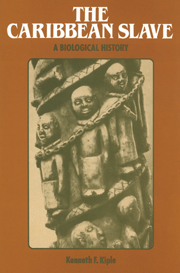Book contents
- Frontmatter
- Contents
- List of Tables
- Preface
- Acknowledgments
- Part I Background and Biology
- Introduction
- 1 The Peoples and Their Pathogens
- 2 West African Diet and Disease
- 3 The Parameters of West African Survival
- Part II Diet, Disease, and Demography
- Part III Pathogens and Politics
- Notes
- Bibliographic Essay
- Index
1 - The Peoples and Their Pathogens
Published online by Cambridge University Press: 19 October 2009
- Frontmatter
- Contents
- List of Tables
- Preface
- Acknowledgments
- Part I Background and Biology
- Introduction
- 1 The Peoples and Their Pathogens
- 2 West African Diet and Disease
- 3 The Parameters of West African Survival
- Part II Diet, Disease, and Demography
- Part III Pathogens and Politics
- Notes
- Bibliographic Essay
- Index
Summary
Medical statistics have shown, in treating on the different races of mankind the dangers of changing one's position on the globe…
G. Pouchet (1864)Wherever the European has trod, death seems to pursue the aboriginal.
Charles Darwin (1836)The European
Since the time of Hippocrates weather and climate have been viewed as important determinants of man's state of health. Consequently when western Europeans began their expansion in the fifteenth century, those bold enough to venture into strange and exotic climates did so conscious of considerable risk to their health from illness as well as from the elements. When Europeans died of new diseases, as they frequently did in tropical regions, they first blamed the sun for throwing their “humors” out of balance, then noxious air became the culprit, and finally they found the climate itself at fault by declaring themselves “unacclimated” and therefore susceptible. Yet in newly discovered temperate zones there was little need to blaspheme the sun or the air or the climate, for there the Europeans seemed truly “acclimated” and in fact tended to enjoy a level of health and a longevity superior even to that of those they had left behind in the mother country.
The Europeans have not prospered in the tropics, however, and in the Caribbean, despite long residence, they still constitute only a tiny minority of 5 percent or less on most of the islands they have dominated for so long. Interestingly, the exceptions are found in areas settled by the Iberians, such as the islands of Cuba and Puerto Rico. Thus, in modern Cuba and even more so in Puerto Rico, European phenotypical characteristics prevail, whereas islands such as Jamaica or Barbados are overwhelmingly black.
- Type
- Chapter
- Information
- The Caribbean SlaveA Biological History, pp. 7 - 22Publisher: Cambridge University PressPrint publication year: 1985

